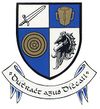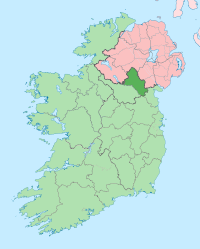County Monaghan
| County Monaghan Contae Mhuineacháin |
||
 |
||
|---|---|---|
| Motto: Dúthracht agus Dícheall (Irish) "Diligence and Best Endeavour" |
||
| Location | ||
|
||
| Statistics | ||
| Province: | Ulster | |
| County seat: | Monaghan | |
| Code: | MN | |
| Area: | 1,294 km2 (500 sq mi) (27th) | |
| Population (2006[1]) | 55,816 (29th) | |
| Website: www.monaghan.ie | ||
County Monaghan (pronounced /ˈmɒnəhən/ – Irish: Contae Mhuineacháin) is one of the twenty-six counties of the Republic of Ireland and one of the thirty-two counties of Ireland. It is located in the province of Ulster. It was named after the town of Monaghan (Irish: Muineachán). The population of the county is 55,816 according to the 2006 census. Monaghan is the sixth smallest of Ireland’s 32 counties in area and fourth smallest in terms of population.[2] It is the second smallest of Ulster’s 9 counties in size and smallest in terms of population.
Contents |
History
In 1585, Sir John Perrot, the natural son of King Henry VIII, visited the area and met with the Irish chieftains. They requested that Ulster be divided into counties and land in the kingdom of Airgíalla be apportioned to each of the McMahon chiefs. A commission was established to accomplish this and County Monaghan came into being. The County was subdivided into the five baronies that exist today: Farney, Cremorne, Dartrey, Monaghan, and Truagh, which was left under the control of the McKenna chieftans.
After the defeat of the rebellion of Hugh O'Neill, The O'Neill and the Ulster chieftains in 1603, the county was not planted like the other counties of Ulster. The lands were instead left in the hands of the native chieftains. In the Irish Rebellion of 1641 the McMahons and their allies joined the general rebellion of Irish Catholics, and following their defeat there was some plantation of the county with Scottish and English families.
Local government
Monaghan is governed locally by the 20 member Monaghan County Council which consists of four wards - Carrickmacross, Castleblayney, Clones and Monaghan. The county forms part of the five seat Cavan-Monaghan Constituency in Dáil Éireann.[3]
The area has historically been staunchly Republican and is nowadays considered a stronghold for the democratic socialist Sinn Fein who are the largest party in the county.
Geography

There are several mountains in the county: Mullyash Mountain, Slieve Beagh (on the border with Tyrone and Fermanagh) and Coolberrin Hill (214 m).
There are also a large number of lakes, including Lough Egish, Lough Fea, Muckno Lough, Lough Avaghon, Inner Lough (in Dartrey Forest), Drumlona Lough, White Lough and Emy Lough.
Rivers in Monaghan include the river Fane (in the southeast of the county and along the border with Louth), river Glyde (along the Louth and Meath borders), the River Blackwater (along the border with County Tyrone) and Dromore River (along the border of County Cavan, linking Cootehill to Ballybay).
Monaghan also has a number of forests, including Rossmore Forest, Dartrey Forest and Dún na Rí Forest Park. Managed by Coillte since 1988, the majority of trees are conifers. Due to a long history of intensive farming practices and recent intensive forestry practices only small pockets of native woodland remain.
The Finn Bridge is a border crossing point across the River Finn between County Monaghan in the Republic of Ireland close to Scotshouse.
Culture
Co. Monaghan is the birthplace of the poet and writer Patrick Kavanagh, who based much of his work in the county. Kavanagh is one of the most significant figures in 20th century Irish Poetry. The poems Stony Grey Soil and Shancoduff refer to the county.
The county has produced several successful artists. Chief among these is George Collie (1904–75), who was born in Carrickmacross and trained at the Dublin Metropolitan School of Art. He was an immensely prolific exhibitor at the Royal Hibernian Academy throughout his lifetime and is represented by works in the collection of the National Gallery of Ireland and the Ulster Museum.
Monaghan was also the home county of the Irish writer Sir Shane Leslie (1885–1971), 3rd Baronet of Glaslough, who lived at Castle Leslie in the north of the county. A Catholic convert, Irish nationalist and first cousin of British Prime Minister Sir Winston Churchill, Leslie became a very important literary figure in the early 1900s. He was a close friend of many important politicians and writers of the day including the American novelist F. Scott Fitzgerald, who dedicated his second novel, The Beautiful and Damned to Leslie.
Monaghan County Museum is recognised as one of the leading provincial museums in Ireland, with a Council of Europe Award (1980), among others, to its credit. Located in Hill Street, Monaghan Town, the museum aims to reflect the history of Co. Monaghan and its people in all its richness and diversity.
The best of the county's architecture developed in the Georgian and Victorian periods and ranges from the grand public spaces of Church Square and the Diamond in Monaghan town to the great country houses of Lough Fea, Carrickmacross, Hilton Park, Clones and Castle Leslie, Glaslough.
Significant ecclesiastical builings include St. Joseph's Roman Catholic Church, Carrickmacross, which houses a set of stained glass windows by the celebrated Irish artist Harry Clarke, the Gothic-Revival St. Patrick's Church of Ireland, Monaghan town and the impressive St. Macartan's Roman Catholic Cathedral, Monaghan town, by J.J. McCarthy.
People
- Tommy Bowe - Rugby Union player, born Monaghan Town, 22 February 1984.[4]
- Oliver Callan - Satirist and mimic, born in the county in December 1980.[5]
- The Rt. Hon. Sir Charles Gavan Duffy (12 April 1816 – 9 February 1903) - Irish Nationalist and Australian politician. Born in Monagahan Town.[6]
- Barry McGuigan - World Boxing Champion 1985. Born in Clones 28 February 1960.[7]
- Patrick Kavanagh (21 October 1904 – 30 November 1967) - Poet.[8]
- "Big Tom" McBride: - Country Singer. Born at Moy near Castleblayney 18 September 1936.[9]
- General Eoin O'Duffy (20 October 1892 – 30 November 1944) - by turns Chief of staff of the Irish Republican Army, Commissioner of An Garda Síochána and leader of the Blueshirts and of Fine Gael, Commander Irish brigade Spanish Civil war. Born near Castleblayney.[10]
- Ardal O'Hanlon - Actor and Comedian.
- Fergal O'Hanlon - IRA member.
- E.P. Shirley - Writer and antiquarian.
- Sir Shane Leslie, 3rd Baronet of Glaslough (1885–1971) - Writer and Political Activist.
- George Collie,(1904–1975) - Artist.
- Patricia McKenna - Former MEP.
- John McKenna, the first manager of Liverpool Football Club along with WE Barclay.
- Alex Haley, African American writer known for Roots: The Saga of an American Family; his grandmother was the illegitimate descendant of Irish-American slaveowner James Jackson III of the Forks of Cypress, who emigrated from Ballybay in County Monaghan.
Towns and villages
| Historical populations | ||
|---|---|---|
| Year | Pop. | %± |
| 1659 | 9,734 | — |
| 1821 | 174,697 | 1694.7% |
| 1831 | 195,536 | 11.9% |
| 1841 | 200,442 | 2.5% |
| 1851 | 141,823 | −29.2% |
| 1861 | 126,482 | −10.8% |
| 1871 | 114,969 | −9.1% |
| 1881 | 102,748 | −10.6% |
| 1891 | 86,206 | −16.1% |
| 1901 | 74,611 | −13.5% |
| 1911 | 71,455 | −4.2% |
| 1926 | 65,131 | −8.9% |
| 1936 | 61,289 | −5.9% |
| 1946 | 57,215 | −6.6% |
| 1951 | 55,345 | −3.3% |
| 1956 | 52,064 | −5.9% |
| 1961 | 47,088 | −9.6% |
| 1966 | 45,732 | −2.9% |
| 1971 | 46,242 | 1.1% |
| 1979 | 50,376 | 8.9% |
| 1981 | 51,192 | 1.6% |
| 1986 | 52,379 | 2.3% |
| 1991 | 51,293 | −2.1% |
| 1996 | 51,313 | 0.0% |
| 2002 | 52,593 | 2.5% |
| 2006 | 55,997 | 6.5% |
| [11] | ||
- Ballinode
- Ballybay
- Carrickmacross
- Castleblayney
- Clones
- Doohamlet
- Emyvale
- Inniskeen
- Glaslough
- Killanny
- Knockatallon
- Magheracloone
- Monaghan
- Newbliss
- Rockcorry
- Scotshouse
- Scotstown
- Smithborough
- Threemilehouse
- Tydavnet
- Tyholland
Subdivisions
Baronies
- Cremorne (Críoch Mhúrn)
- Dartree (Dartraí)
- Farney (Fearnaigh)
- Monaghan (Muineachán)
- Trough (an Triúcha)
Parishes
Townlands
Twinning
County Monaghan is twinned with the following places:
 Prince Edward Island, Canada
Prince Edward Island, Canada Miramichi, New Brunswick, Canada
Miramichi, New Brunswick, Canada Peterborough, Ontario, Canada
Peterborough, Ontario, Canada
See also
- List of abbeys and priories in the Republic of Ireland (County Monaghan)
Notes
- ↑ From Census 2006 Preliminary Report - Table 1
- ↑ Corry, Eoghan (2005). The GAA Book of Lists. Hodder Headline Ireland. pp. 186–191.
- ↑ "2009 Local Election - Electoral Area details". http://www.electionsireland.org/results/local/council.cfm?election=2009L&area=265. Retrieved 27 May 2010.
- ↑ "Tommy Bowe 2009 British and Irish Lions Squad Profile". http://www.lions-tour.com/the_lions/profile.asp?id=62. Retrieved 10 November 2009.
- ↑ Chris True. "Biography: Monaghan Mimic". all music. http://www.allmusic.com/cg/amg.dll?p=amg&sql=11:0ifixzu5ldde~T1. Retrieved 10 November 2009.
- ↑ Joy E. Parnaby (1972). "Duffy, Sir Charles Gavan (1816 - 1903)". Australian Dictionary of Biography. Melbourne University Press. http://adbonline.anu.edu.au/biogs/A040109b.htm. Retrieved 10 November 2009.
- ↑ "Barry McGuigan". BoxRec.com Boxing Encyclopedia. http://www.boxrec.com/list_bouts.php?human_id=012746&cat=boxer. Retrieved 10 November 2009.
- ↑ "Life". Patrick Kavanagh 1904 – 1967. Patrick Kavanagh Trust, Trinity College Dublin. http://www.tcd.ie/English/patrickkavanagh/life.html. Retrieved 10 November 2009.
- ↑ "Big Tom". BBC Music. BBC. http://www.bbc.co.uk/music/artists/3ead0fc5-d162-4a3b-87d6-cbaca9d1d853. Retrieved 10 November 2009.
- ↑ "GEN. EOIN O'DUFFY (1892 -1944)". Cumann na nGaedhael History. Collins 22 Society. http://generalmichaelcollins.com/Fine_Gael/Eoin_O_Duffy.html. Retrieved 10 November 2009.
- ↑ for post 1821 figures, 1653 and 1659 figures from Civil Survey Census of those years, Paper of Mr Hardinge to Royal Irish Academy March 14, 1865, For a discussion on he accuracy of pre-famine census returns see JJ Lee “On the accuracy of the Pre-famine Irish censuses Irish Population, Economy and Society edited by JM Goldstrom and LA Clarkson (1981) p54, in and also New Developments in Irish Population History, 1700-1850 by Joel Mokyr and Cormac O Grada in The Economic History Review, New Series, Vol. 37, No. 4 (Nov., 1984), pp. 473-488.
External links
- Monaghan County Council
- Monaghan Tourism Map
- Sliabh Beagh Hotel and Tourism Centre
- History: Overview and Resources, The McMahon Story, Clogherhistory.ie
- Description of County Monaghan (1900)
- Monaghan Architecture
- US protest as map of Monaghan bears an uncanny resemblance to an outline map of Iraq
|
|||||||||||||||||
|
||||||||||||||||||||


